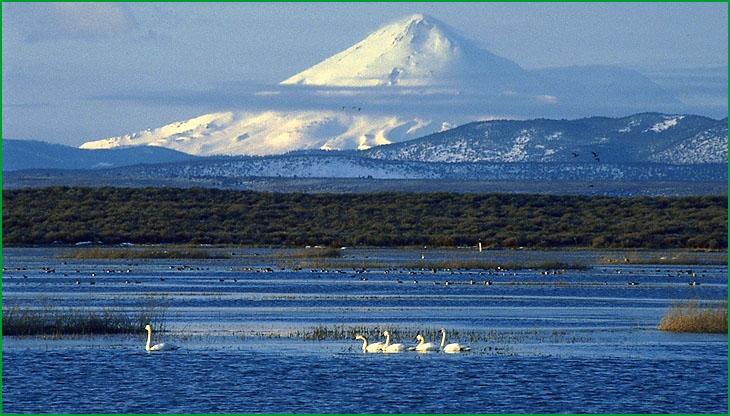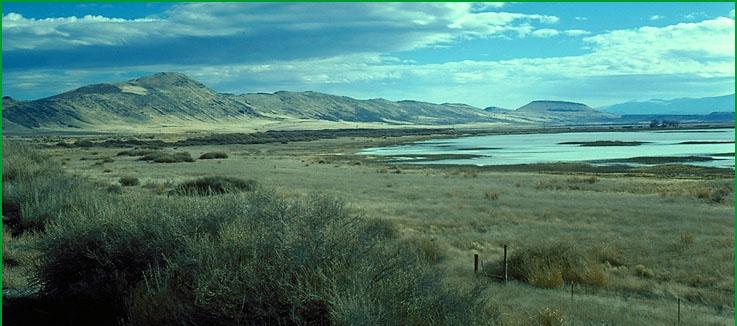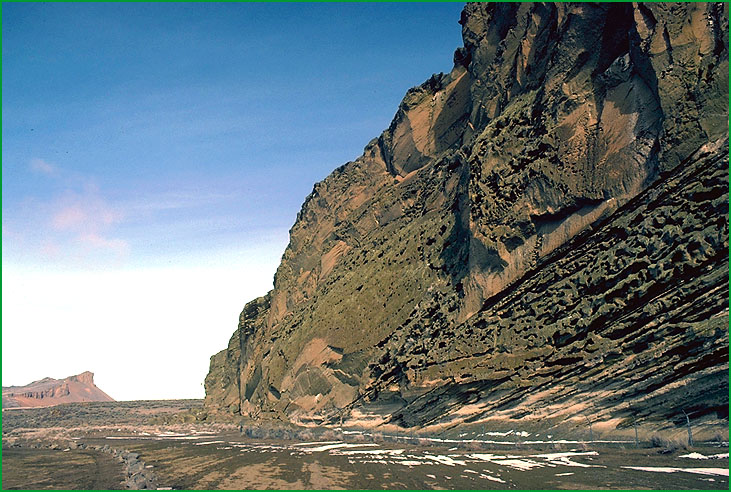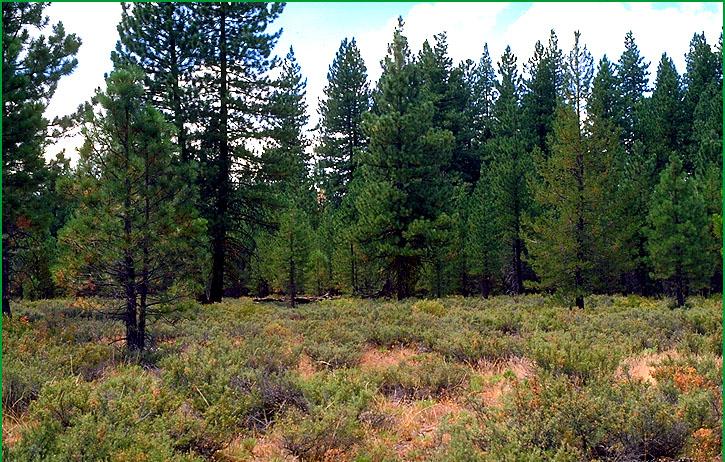 | Lower Klamath - Tule Lake Basins- Devilís Garden-Lower Klamath - Tule Lake Basins-Crowder Flat |
Lower Klamath - Tule Lake Basins- Subsection M261Ga, Lower Klamath Lake area, M261Dh midground, Mt. Shasta in background ó James R. Nelson |
Subsection M261Ga ó USDA |
Subsection M261Ga, Praire Falcon cliff ó James R. Nelson |
Devilís Garden-Subsection M261Gb, north of Big Sage Reservoir ó Scott Miles |
http://www.fs.fed.us/r5/projects/ecoregions/m261ga.htm
Subsection M261Ga
Lower Klamath - Tule Lake Basins
This subsection is a lake plain that is occupied in part by the Lower Klamath and Tule Lakes. The climate is temperate and semi-arid to subhumid. MLRA 21f.
Lithology and Stratigraphy. Quaternary lacustrine deposits dominate this subsection.
Geomorphology. The landform is a nearly level lake plain. The elevation range is about 4037 to 4100 feet. Fluvial erosion, lacustrine deposition, and freeze-thaw are the main geomorphic processes.
Soils. Soils are mostly Typic Haplaquands; Aquandic Haplaquolls; Typic, Fluvaquentic, Torripsammentic, and Pachic Haploxerolls; Limnic Borohemists; Xerollic Durorthids; and Aquic Haplodurids. The soils are well to very poorly drained. Soil temperature regimes are mesic. Soil moisture regimes are aridic, xeric, and aquic.
Vegetation. The predominant natural plant communities are Big sagebrush series, Mixed saltbush series, Sedge meadow communities, and Emergent aquatic communities.
Characteristic series by lifeform include:
Marshes: Bulrush series, Bulrush - cattail series, Cattail series.
Grasslands: Alkali sacaton series, Ashy ryegrass series, Common reedgrass series, Creeping ryegrass series, Idaho fescue series, Indian ricegrass series, Needle-and-thread series, Pickleweed series, Saltgrass series.
Shrublands: Big sagebrush series, Bitterbush series, Greasewood series, Iodine bush series, Mixed saltbush series, Parry rabbitbrush series, Rubber rabbitbrush series, Shadscale series.
Climate. The mean annual precipitation is about 10 to 20 inches. Much of the precipitation is snow. Mean annual temperature is about 46į to 50į F. The mean freeze-free period is in the range from 100 to 125 days.
Surface Water. Runoff is very slow. Drainage is facilitated by artificial canals. Any water that drains from the lake plain flows to the Klamath River.
Subsection M261Gb
Devilís Garden
This subsection is a volcanic plateau between Tule Lake and Goose Lake, excluding higher land on Crowder Flat (subsection M261Gc). The climate is temperate and semi-arid to subhumid. MLRA 21e.
Lithology and Stratigraphy. The bedrock is predominantly Pleistocene basalt and lesser amounts of Pliocene basalt and Tertiary andesite and pyroclastic rocks. Most of the Tertiary volcanic rocks are west of Clear Lake Reservoir. There are some alluvial and lacustrine deposits in small depressions. Most of the faults are aligned north-south; some curve around toward the northwest.
Geomorphology. The main landform is a gently to moderately sloping plateau with few moderately steep to steep hills and scarps. There are a few late Quaternary cinder cones on the west side of the subsection. The plateau lacks a well integrated drainage system. There are few stream channels and many small closed depressions, although much of the subsection drains to streams in the Pit or Klamath River systems. Basin-fill on basin floors in small depressions is a small but important part of the subsection. The elevation range is from about 4100 feet adjacent to Tule Lake up to 5582 feet on Doublehead Mountain. Faulting, fluvial erosion and deposition and freeze-thaw are the main geomorphic processes.
Soils. Soils on uplands are mostly Typic, Lithic, Aridic, Pachic, and Pachic Ultic Argixerolls; Xerollic, Abruptic Xerollic, and shallow Xerollic Durargids; Lithic Xerollic Torriorthents; Xerollic Camborthids; Pachic Haploxerolls; and Argiduridic and Palexerollic Durixerolls. Soils on basin floors are most commonly Typic Chromoxererts and Xeric Endoaquerts. The soils are well drained on upland and well to poorly drained on basin floors. Soil temperature regimes are mostly mesic. Soil moisture regimes are mostly aridic and xeric, but some are aquic on basin floors.
Vegetation. The predominant natural plant communities are Big sagebrush series and Western juniper series. Low sagebrush series is common on shallow soils, and Curlleaf mountain mahogany is common on very stony soils. Silver sagebrush and Sedge meadow communities occur on floodplains and basin floors.
Characteristic series by lifeform include:
Grasslands: Ashy ryegrass series, Bluebunch wheatgrass series, California oatgrass series, Creeping ryegrass series, Idaho fescue series, Indian ricegrass series, Nebraska sedge series, Needle-and-thread series, Shorthair sedge series.
Shrublands: Big sagebrush series, Bitterbrush series, Parry rabbitbrush series, Rubber rabbitbrush series.
Forests and woodlands: Aspen series, Curlleaf mountain-mahogany series, Knobcone pine series, Western juniper series.
Climate. The mean annual precipitation is about 10 to 20 inches. Much of the precipitation is snow. Mean annual temperature is about 45į to 50į F. The mean freeze-free period is in the range from 75 to 125 days.
Surface Water. Runoff from uplands is rapid. Water drains down through joints in the basalt to the ground water reservoir, limiting overland flow of water and development of stream channels. Much of the surface drainage is internal, to closed depressions in the subsection, and water ponds in many small depressions. There are few stream and most of those are dry during summer. The largest of several reservoirs is Clear Lake. Streams that flow from the subsection drain to Goose Lake, the Lower Klamath Lake basin, the Pit River, or tributaries of the Pit River.
Subsection M261Gc
Crowder Flat
This subsection consists of the higher part of a volcanic plateau west of Goose Lake. The climate is temperate to cold, and subhumid. MLRA 21e.
Lithology and Stratigraphy. The bedrock is predominantly Miocene basalt and lesser amounts of Pleistocene basalt and Tertiary pyroclastic rocks. There are some alluvial and lacustrine deposits in small depressions. Most of the faults are aligned north-south or toward the northwest.
Geomorphology. The main landform is a gently to moderately sloping plateau with few low moderately steep to steep scarps. The plateau has a moderately well integrated drainage system, with few small closed depressions. The elevation range is from about 4800 feet adjacent to Goose Lake up to 6062 feet on Muldoon Mountain. Fluvial erosion and freeze-thaw are the main geomorphic processes.
Soils. The soils are mostly Typic, Lithic, Lithic Ultic, Pachic, Pachic Ultic, and Ultic Argixerolls. The soils are well drained. Soil temperature regimes are mostly frigid. Soil moisture regimes are xeric.
Vegetation. The predominant natural plant communities are Ponderosa pine series and White fir series. Curlleaf mountain mahogany series is common on very stony soils. Low sagebrush series occurs on shallow soils.
Characteristic series by lifeform include:
Grasslands: Ashy ryegrass series, Bluebunch wheatgrass series, California oatgrass series, Creeping ryegrass series, Idaho fescue series, Indian ricegrass series, Nebraska sedge series, Needle-and-thread series.
Shrublands: Big sagebrush series, Bitterbrush series, Parry rabbitbrush series, Rubber rabbitbrush series.
Forests and woodlands: Curlleaf mountain-mahogany series, Ponderosa pine series, White fir series.
Climate. The mean annual precipitation is about 20 to 30 inches. Much of the precipitation is snow. Mean annual temperature is about 42į to 48į F. The mean freeze-free period is in the range from 50 to 100 days.
Surface Water. Runoff from uplands is rapid; much of it drains down through joints in the basalt to the ground water reservoir, limiting overland flow of water and development of stream channels. There are few streams and most of those are dry during at least part of summer. Streams that flow from the subsection drain to Goose Lake or across Devilís Garden to the Lower Klamath Lake basin or the Pit River.



